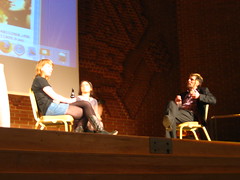 Image via WikipediaThat’s the title of the talk by the first foreign speaker1 at Spletne urice — Richard Rutter from Clearleft, who’s really a great guy and a great speaker.
Image via WikipediaThat’s the title of the talk by the first foreign speaker1 at Spletne urice — Richard Rutter from Clearleft, who’s really a great guy and a great speaker.
Web Typography is one of the topics I really care about and I think it’s an issue that iswas a bit overlooked in our local community. After my talk last year about fonts and possible ways to use / embed them I am happy that we got Richard to come to Slovenia to talk about this — who could be better than the author of The Elements of Typographic Style Applied to the Web.
The talk went great2 (Cyberpipe filled up after the first few minutes) and it was followed by a good Q&A session. In the session I mentioned that a font foundry released a font that is free for use on the web and thus free for embeding — the foundry is called FDI fonts.info — you can read their press release or download Graublau Sans Web and Logotypia Pro for free. After the talk we went for a beer in Metropol (just above Cyberpipe) and then another one later on in the city center.
All in all it was great having Richard here and I guess he liked it too. I hope he’ll put in a good word for us and we’ll get even more foreign speakers to come to Ljubljana and share their in–depth knowledge of specific areas of webdesign and development3.
I would also like to thank our silent sponsor Parsek Interactive that took care of the air fare and the hotel bill and also Zemanta that shared their work space with Richard today4.
- Technically Daniel P. Fischer was the first, but he gave his talk as part of the HAIP festival and his stay and talk was organized by the Cyberpipe crew. So what I’m trying to say is that Richard was the first speaker I organized by myself. back
- If you missed the talk the slides are here and the video should be online in a couple of weeks. back
- Any volunteer speakers? Any suggestions? Sponsors maybe? back
- Did you notice that I tried to punctuate with the correct apostophes, en dashes, em dashes, elipses’… It’s not that easy — somebody should create a WordPress plugin for this. back





